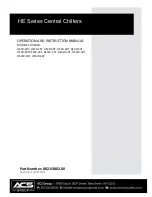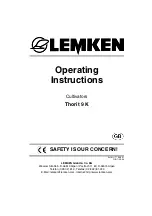
132
YORK INTERNATIONAL
FORM 201.19-NM8 (804)
oil. This should be of no con cern and lasts for
only a short time.
#
4. Check the system operating parameters. Do this
by selecting various displays such as pres sures
and tem per a tures. Compare these to test gauge
readings.
CHECKING SUBCOOLING AND SUPERHEAT
The subcooling should always be checked when charg-
ing the system with refrigerant and/or before setting
the superheat.
When the refrigerant charge is correct, there will be no
bubbles in the liquid sight glass with the system op er -
at ing under full load conditions, and there will be 12 -
15°F (6 - 8°C) subcooled liquid leaving the condenser.
An overcharged system should be guarded against.
Ev i denc es of overcharge are as follows:
a. If a system is overcharged, the discharge pres sure will
be higher than normal. (Normal discharge/con dens ing
pres sure can be found in the refrigerant tem per a ture/
pres sure chart; use entering air tem per a ture +30°F
(17°C) for nor mal condensing tem per a ture.
b. The temperature of the liquid refrigerant out of the
con dens er should be not be more than 15°F (8°C)
less than the condensing temperature (The tem-
per a ture cor re spond ing to the condensing pressure
from the re frig er ant tem per a ture/pressure chart).
The subcooling temperature of each system should be
calculated by recording the temperature of the liquid
line at the outlet of the condenser and subtracting it
from the recorded liquid line pressure at the liquid stop
valve, con vert ed to temperature from the temperature/
pres sure chart.
Example:
Liquid line pressure =
202 PSIG converted to 102°F (39°C)
minus liquid line temp. - 87°F (31°C)
SUBCOOLING = 15°F (8°C)
The subcooling should be adjusted to 12-15°F (6-8°C).
#
1. Record the liquid line pressure and its cor re -
spond ing temperature, liquid line tem per a ture
and subcooling below:
SYS 1 SYS 2 SYS 3 SYS 4
Liq Line Press =
PSIG
(kPa)
Temp =
ºF
(ºC)
Liq Line Temp =
ºF
(ºC)
Subcooling =
ºF
(ºC)
Sys #1 Motor Protector Input = ________________ Volts
Sys #2 Motor Protector Input = ________________ Volts
Sys #3 Motor Protector Input = ________________ Volts
Sys #4 Motor Protector Input = ________________ Volts
Typically, these values should not be
changed. Incorrect programming may
cause catastrophic chiller failure.
#
11.Check the Motor Protector Dip Switch program-
ming. The switches should correctly set at the
factory. The switches may be checked visibly
and the total ON switches added using binary
addition to determine the setting or by reading
the display on the motor protector. See Section
8 for programming information. Record the
values below:
Sys #1 Wires thru each hole of the C.T. = ____________
Sys #1 MP Setting = _____________________________
Sys #2 Wires thru each hole of the C.T. = ____________
Sys #2 MP Setting = ____________________________
Sys #3 Wires thru each hole of the C.T. = ____________
Sys #3 MP Setting = _____________________________
Sys #4 Wires thru each hole of the C.T. = ____________
Sys #4 MP Setting = ____________________________
INITIAL START-UP
After the control panel has been pro grammed and the
com pres sor heater has been on for 24 hours prior to
start-up, the chiller may be placed into operation.
#
1. Place the System Switches on the Mi cro pro -
ces sor Board to the ON position.
#
2. The compressor will start and a fl ow of re frig -
er ant will be not ed in the sight glass. Af ter
sev er al min utes of op er a tion, the bub bles in the
sight glass will dis ap pear and there will be a
solid col umn of liquid when the TXV sta bi liz es.
After the water tem per a ture sta bi liz es at de sired
op er at ing con di tions, the sight glass should be
clear.
#
3. Allow the compressor to run a short time, be ing
ready to stop it immediately if any unusual noise
or adverse conditions de vel op. Im me di ate ly at
start-up, the com pres sor will make sounds dif-
fer ent from its normal high pitched sound. This
is due to the com pres sor com ing up to speed and
lubrication chang ing from liq uid re frig er ant to
Technical Data
Summary of Contents for YCAS Series
Page 43: ...43 YORK INTERNATIONAL FORM 201 19 NM8 804 5 This page intentionally left blank...
Page 45: ...45 YORK INTERNATIONAL FORM 201 19 NM8 804 6 This page intentionally left blank...
Page 77: ...77 YORK INTERNATIONAL FORM 201 19 NM8 804 This page intentionally left blank...
Page 81: ...81 YORK INTERNATIONAL FORM 201 19 NM8 804 LD10047 035 16253 104 Rev D Power Panel...
Page 93: ...93 YORK INTERNATIONAL FORM 201 19 NM8 804 This page intentionally left blank...
Page 147: ...147 YORK INTERNATIONAL FORM 201 19 NM8 804 8 This page intentionally left blank...
Page 205: ...205 YORK INTERNATIONAL FORM 201 19 NM8 804 8 This page intentionally left blank...
















































